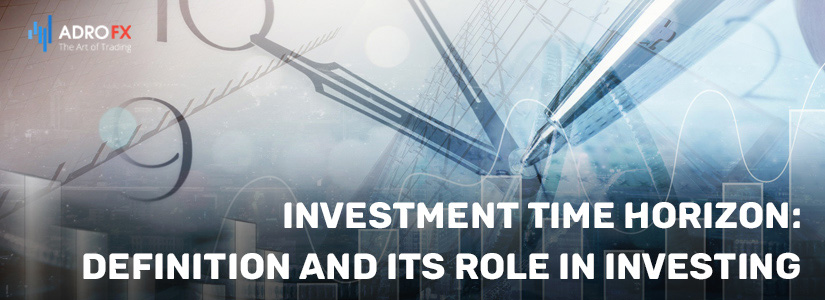Investment Time Horizon: Definition and Its Role in Investing

Beginning investors who come to the stock market are inevitably confronted with terminology that is new to them. An accurate understanding of this vocabulary makes it possible to quickly understand the principles of the investment mechanism and learn how to make all necessary calculations without errors. In general, for a beginner investor to start meaningful actions it is enough to assimilate a limited set of the most important concepts, which includes the investment horizon.
Investment Horizon - What Do You Need to Know?
The investment horizon is a multifaceted concept, and authors of publications and books on investing often use it in different ways. It is viewed as an interval of time:
- necessary to achieve the set investment goal;
- during which an open stock exchange position of the investor is held;
- during which the investor intends to invest in investment instruments.
In general, all these points of view are only special cases of the general definition of an investment horizon. It can be formulated as follows.
The investment horizon is the time during which an investor plans to invest funds in certain projects and assets, expecting to achieve the set goal at the expense of the profit received. In this case, the notion of "investment of funds" includes the initial investment capital, additional investments, and reinvestment of income.
The investment horizon is one of the fundamental concepts for any investor. It must necessarily be defined (indicated) in your personal investment plan.

How Can You Determine the Investment Horizon?
There are two possible approaches to planning an investment horizon:
- as parts of the investment goal;
- calculative.
In the first case, the goal is formulated as specifically as possible, with an indication of the amount to be received and the terms for achieving it. This option is most suitable for beginning investors, as it allows choosing an investment strategy and defining a set of assets for investments.
A variant of investment planning with this approach looks as follows:
- Formulation of the goal. It includes calculation of the target amount and determination of the investment horizon. The goal is specified as precisely as possible, for example, "to save $50k for my child's education within 5 years".
- Profiling. At this stage an investment or risk profile is prepared, risk appetite and acceptable level are determined, and accordingly a type of investment strategy is selected.
- Selection of assets for realization of the goal within a given investment horizon.
The calculation method of investment horizon planning is used by experienced investors, who can not only formulate an investment goal, but also correctly take into account important factors that affect its achievement:
- the initial amount of investment capital;
- possibility and frequency of regular additional investments, including reinvestments;
- acceptable risk level;
- profitability and volatility of investment instruments, including those traded on various markets;
- the time required to maintain the investment.
In this case the stages of compiling a personal investment plan change somewhat:
- The financial goal of the investment is formulated (the amount the investor wants to end up with).
- Initial capital and amounts of regular additional investments are determined.
- Assets for investment are chosen, the expected profitability is predicted.
- Horizon of investment is calculated.
In general both algorithms do not contradict each other and can be combined. In this case the upper limit of investment horizon is determined during initial goal setting, and its framework is adjusted after assets selection and expected return calculation.

What Investment Horizon Depends on?
A beginning investor should know what factors and how they affect the investment horizon - the length of time in which an investment goal can be achieved. These include:
- Target amount - the total result that the investor wants to get as a result of the investment of equity capital. With its increase it is necessary to expand a horizon of investment.
- Initial amount of investment capital and amount of additional investments. The more funds invested, the easier it is to achieve the desired result. Thus, an increase in the investment capital and regular additional investments reduces the investment horizon.
- The level of risk acceptable to the investor. The higher it is, the more volatile assets can be used when investing, which in turn reduces the time to achieve the investment goal. However, the correlation here is not that straightforward: if the acceptable risk level is exceeded, it is necessary to close the open positions with a loss. Its compensation in the future may significantly delay the moment of achieving the desired end result (increase the investment horizon).
The choice of assets has the greatest impact on the investment horizon. Their profitability is directly related to the time of investing: the higher it is, the lower the investment horizon.
- Conservative instruments (bank deposits, government bonds) have low yields and, accordingly, do not allow you to achieve your goal quickly. At the same time, the reliability of such investments is very high.
- High-yielding assets naturally reduce the investment horizon but increase risks along with it. In this case, there is a danger not only of losing part of the invested assets, which postpones the moment the goal is attained, but also of parting with the whole investment capital. However, investors should take into consideration the general nature of the market. For example, the stock market is a priori growing, which allows investing for a long period of time not only to "wait out" drawdowns, but also to make considerable profit. Currency and futures markets, some assets of the commodities market do not have such properties.
That is why experienced investors relate the investment horizon to the portfolio structure:
- For short-term (1-3 years) investments it is recommended to choose assets with high reliability and low volatility. The ratio between conservative and profitable assets is about 80 to 20 (80 percent - bonds, preferably government bonds, 20 percent - stocks, preference should be given to blue chips).
- With an investment horizon of 5-10 years, you can increase the percentage of equities to 40-50%. Part of the bond portfolio can also be overhauled, placing up to half of its volume in corporate debt securities of reliable issuers.
- A long-term investment horizon (10 years or more) allows you to focus on high-yield assets. It is advisable to increase the proportion of shares to 80 percent, paying attention not only to "blue chips", but also to interesting second-tier issuers.
All of the above considerations apply to a limited investment horizon. However, it can also be infinite, for example, when the goal of investments is to receive a permanent basic income. In this case, assets should be selected based on considerations of the right mix of dividend/coupon and speculative income.
Investment Horizon for Beginners
There are no fundamental restrictions on the choice of an investment horizon for beginners. The only recommendation that experienced investors give is not to invest all of the capital in a long-term portfolio. High-quality portfolio formation requires a solid knowledge and experience with assets of different markets and industries.
To accumulate such experience, it is better to allocate part of the funds to short-term (1-3 years) investments. It is advisable to follow all recommendations on the selection of reliable assets and diversification.
About AdroFx
Established in 2018, AdroFx is known for its high technology and its ability to deliver high-quality brokerage services in more than 200 countries around the world. AdroFx makes every effort to keep its customers satisfied and to meet all the trading needs of any trader. With the five types of trading accounts, we have all it takes to fit any traders` needs and styles. The company provides access to 115+ trading instruments, including currencies, metals, stocks, and cryptocurrencies, which make it possible to make the most out of trading on the financial markets. Considering all the above, AdroFx is the perfect variant for anyone who doesn't settle for less than the best.









